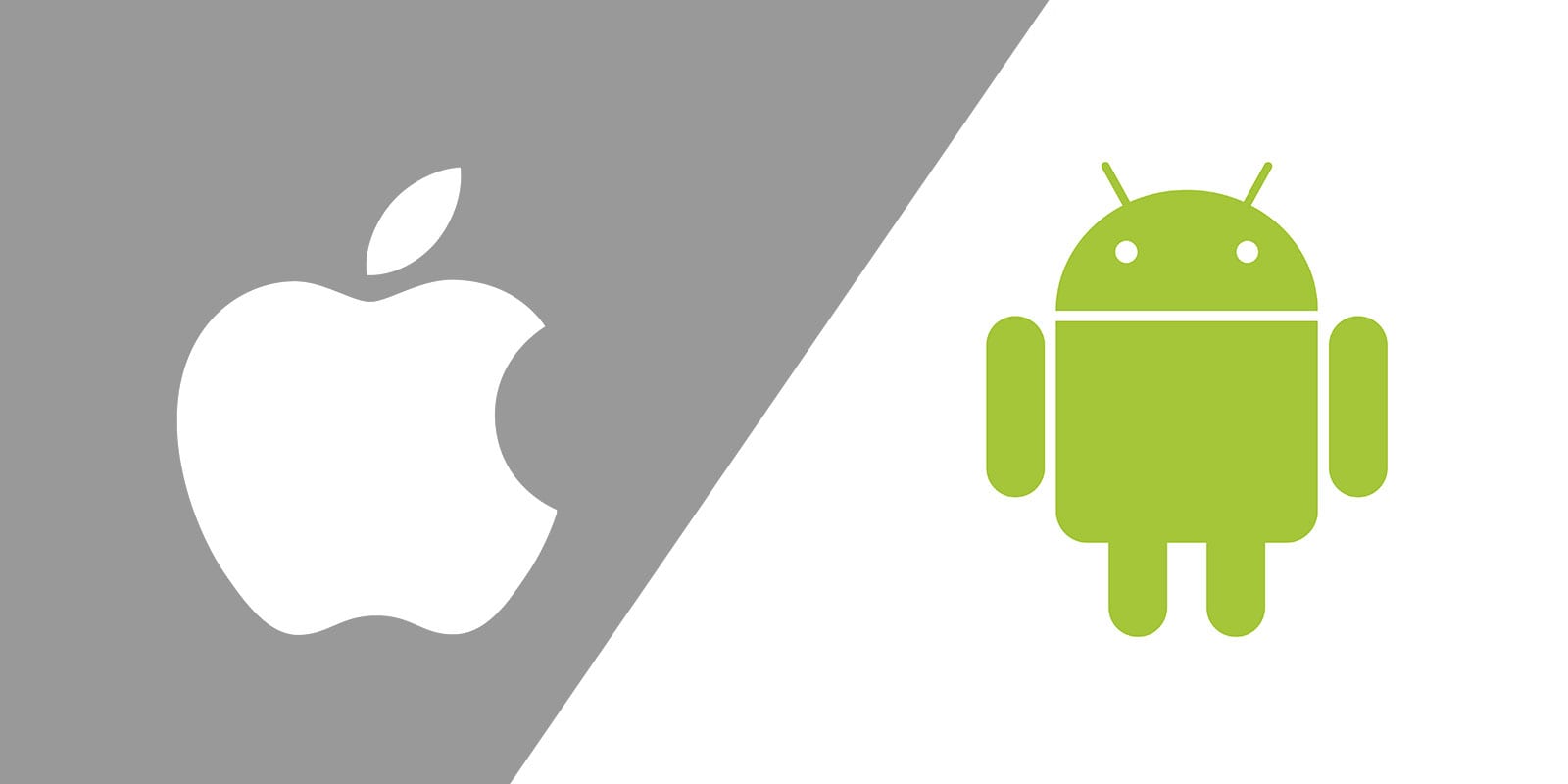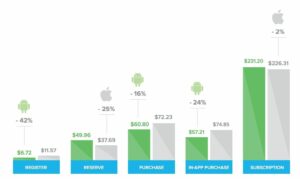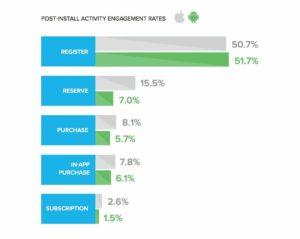iPhone Users vs. Android Users: How Do They Behave Differently?

Smartphones are becoming small extensions of us and send messages about who we are to those around us.
Our phones are now an integral part of our lives and we’re more mobile than ever. One of the most recent US Mobile App Reports from comScore indicates that:
- We now spend 50% of our digital media time in smartphone apps
- Time spent in mobile apps absolutely dominates over mobile web
- We most often only access 20 or fewer apps in a month, but we position them on our screens in a way that makes them easily accessible
And what’s even more interesting is the fact that our choice of smartphone and mobile platform can speak volumes about our behavior, habits, and even personality.
This post will help you understand the different context your app may face between iOS and Android users. It will also show you why you may want to measure your app’s success differently because of this.
Let’s go!
Create a Mobile App for FREE with BuildFire
But first, the basics on smartphone users and the mobile OS market share
Let’s begin by covering some basics on the mobile operating systems market. Android devices and Apple devices combined make up over 97% of the mobile OS global market share. And as of August 2017, Android smartphones take up almost exactly two thirds (64%) of those!
Because of its broad price range and a lower entry-level price point, Android has the largest global share in lower income areas and developing nations. It holds an advantage over Apple in emerging markets such as Asia and Africa.
Apple, however, dominates the profit share despite Google’s global dominance of market share because the average iOS user is more active that the average Android user.
They offer different capabilities
While these two operating systems dominate the percentage of smartphones sold across the globe, there are several key differences between Android and iOS that affect user experience at its foundation and the choices we make when we engage with either of them.
Apple is incredibly strict when it comes to app submissions, push notifications, rules and timelines, and they push operating system updates to users to ensure consistent experience for them.
On another hand, Android apps and app listings can be updated without a human review. They are also fragmented across various phone manufacturers such as Samsung, LG, HTC and Motorola, which gives a customizable experience to the end user.
Now, both of these scenarios come with benefits and disadvantages, and if you ask the users of either iOS or Android, they will tell you it’s exactly what they want. Apple users are usually loyal to the consistent experience across all their devices and any updates that come along, while Android users vouch for the freedom and customizability their devices provide.
This just goes to show that, while all smartphones are similar in their core purpose, each user sees their own smartphone in a unique way.
Android vs. iOS Users: Differences in core demographics
As mentioned earlier, Android currently has the largest global platform share compared to the iOS market share, with a particular prominence in lower income areas and developing nations. Comparatively, iOS users typically have higher income, higher education levels, more engagement, and spend more per app. Of course, that doesn’t mean that those who have those same characteristics won’t own an Android device and will only use iOS devices. Instead, this data is simply indicative of the general Android population.
Men are slightly more likely to be iOS users than women. Android seems to be the most common platform among all age groups, but its edge over iOS was a bit smaller in the 65+ age bracket.
While the age and gender differences of users between platforms probably aren’t significant enough to influence a platform decision for an app, income and location definitely shouldn’t be neglected. As you’ll see below, this can impact actions like in-app purchases and paid subscriptions, which plays a huge role for a business model that relies on such behavior!
Does personality play a role?
Believe it or not, we apparently choose our smartphones based on how introverted or extroverted we are! According to a study, Android users are less extroverted than iPhone users, and they are perceived to have greater levels of honesty and humility.
Android users are also more likely to prefer saving their money and to say they tend to follow, while their iOS counterparts prefer spending their money and they’re more likely to say they tend to lead.
However, I wouldn’t be too concerned about the personality differences when it comes to the platform choice for an app; every user is unique in a much more granular way than a study can show. As long as you focus on your app’s goal and your user’s intent, you’re good to go!
The approach to technology
According to a poll conducted by Hunch.com, iOS users are more likely to be early adopters and to have first used the internet before 1992. They also seem to be loyal to Apple, as they are more than 100% more likely to own a Mac computer compared to Android users.
On the other side of the spectrum, Android users seem to be late adopters and they are less likely to backup their computer. They prefer a full-featured device at the expense of its appearance, and they are more likely to use Yahoo Mail as opposed to owning an email domain associated with work or their website.
Get Started With BuildFire Today!
Pick a template to start designing the app yourself, or let our professional design team build it for you.
- Mobile app development for iOS & Android
- No coding required
- 150+ pre-built features
- Unlimited customization
- 14 day free trial
Push notifications behavior
It’s fascinating to see that even actions like reacting to push notifications vary so much between Android and iOS users. This will help you benchmark your open rates better based on the device your user is on!
About 3.5% of Android users open push notifications, while just under 1.8% iOS users open them. One of the reasons for this discrepancy may be the fact that push notifications on Android stay visible on the lock screen until the user actions on them. On an iPhone, they disappear after the first screen unlock.
There’s a chance that this exact difference in features causes iOS users to open push notifications quicker. It only takes an average of 7 minutes for an iOS user to respond to a push notification, compared to 48 minutes for Android user. This may indicate a higher quality of interaction when it comes to Apple users.
Acquisition, in-app engagement and retention
Liftoff released an interesting set of data that covers the cost necessary to acquire a mobile user who subscribes to a paid service, as well as the post-install engagement activity.
This data is segmented based on whether the app main goal was registration, reservation, purchase, in-app purchase, or a subscription. Here’s how the cost per acquisition varies between iOS and Android:
(source: Liftoff 2016 Mobile Index)
When it comes to user engagement after installing the app, iOS outperforms Android in all the mentioned categories, except for the registrations, where Android has a narrow advantage:
(source: Liftoff 2016 Mobile Index)
On average, iPhone users engage with their smartphone apps for nine more hours in a given month than Android users.
iPhone owners are sometimes described as smartphone “power users” and tend to engage with more content on average. On another hand, the Android platform has a greater number of media users in each category.
This means you may want to consider whether audience size or engagement is the more important determinant of success for your app. Which one means more to you: a higher number of users, or the users that engage more? A lot will depend on the goal you set for your mobile app.
Consumer spend and mCommerce
As I mentioned earlier, there seems to be a gap between the purchase power of an average iPhone user compared to an Android user.
The median iPhone app user earns $85,000 per year, which is 40% more than the median Android phone user with an annual income of $61,000. And even though Android has far more downloads than iOS, iPhone users spend twice as much as their Android counterparts. Also, in Q1 of 2017, iOS spending jumped 45% year-on-year, while Android’s grew 40%.
The average in-app shopping check is four times higher for an iOS user! If you’d want to develop a mobile shopping app, iOS development would make all the sense. However, Android users love digital utility apps like launchers, anti-virus apps and performance boosters, and they are ready to pay for those and spend on them 5 times more than iOS users.
iPhone owners are also more likely to make purchases on their phones on a regular basis. These are important considerations for both retail app developers and those seeking to monetize via paid apps or in-app purchase. Mobile ads are the main source of revenue generation in Android apps.
Loyalty to a specific platform
When compared to the Google Android user base, iOS users are more loyal and have more spending power. As I touched on briefly earlier, Android users love the openness of the platform and they like to customize their device, while iOS users like to keep their devices straightforward and spend more time on trying out various apps.
It seems that iPhone owners tend to think very highly of their devices, and are likely to remain iPhone users over time as a result of that. And while the percentage of highly satisfied Android owners is fairly high – 48% – it is quite below the 62% of iPhone owners that feel the same about their smartphone.
When to choose which one
With the growth of both Apple’s App Store and Google’s Play Store, the ideal development path you can take is hybrid development for both platforms. The majority of apps can work perfectly across both, and it’s easier to build that way upfront, instead of building for one app store and adding the other one over time.
If you’re set on choosing one platform over the other, however, keep the following in mind:
- Developing for Android makes sense if your target audience is significantly focused on Android, as well as when you’re focusing on customizing Android user experience and adding to the personalization power that Android has
- iOS first makes sense when your goals align with the consumer spend, high in-app engagement and loyalty that makes iPhone users valuable; Apple has also reduced approval times and the time to market is working to your benefit
Hopefully, this data gave you some insight into your current and/or future app audience. With some significant differences that we covered, you can now look at your engagement rates, in-app behavior and your success measurement with more insight into what lies behind your user’s actions.
Which differences do you find the most relevant to your current or future app development? Let us know!

